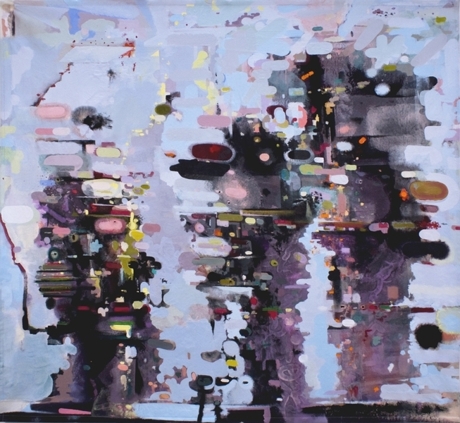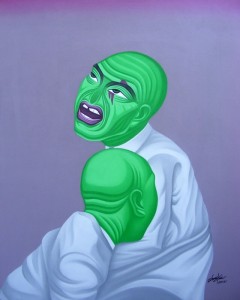Kate Barsby, Victoria Browne, James Ryan, Simon Haddock
9th Sep– 2nd Oct 2010
Visually we collect endless shapes and patterns, images and forms, that we generate, recognise and then collage in our mind-scape. We like to order, structure and compartmentalise our memories; we use them to navigate ourselves through our physical and cognitive world. These are triggers for actions and direction either trivial or important that define us in the world.
Occupied Order brings together 4 artists in an expressional journey through our environment whether domestic, urban/rural or political. Victoria Browne’s beautifully crafted polymergravure prints, the result of a three year project researching CERN are a stunning example of this as is Kate Barnsby’s installation exploring language in a simulated world.
James Ryan intelligently paints layers of geometric patterns on fabric which have emerged from the man-made environment and structure. Perhaps these abstract planes are thoughts that reflect on the city surface, or an emotional positioning that we find, or self remembering – ontological and phenomenological. Then Simon Haddock’s bombastic explosions of colour and form take us on an exciting journey through landscape. We are shown the energy of an all-encompassing existence. This is not mapping or landscape art, in Occupied Order we are shown layers of time and life within the nature of being.
Kate Barsby has been specially commissioned to create a piece for the window space in the gallery, she is currently studying for her Masters Degree in Fine Art at Central St. Martins. Her practice explores the language and idioms of production and consumption within an increasingly simulated environment. Kate positions her practice at the ‘interface’ between the concrete and abstract, between technology and humanity, utilising materials as diverse as CGI animation, live trees, spangles and “cliches” to explore this complex and collaborative exchange.
Victoria Browne’s work acts as a diversion from the increasingly rapid and speculative media response to current socio-political events. This re-writing relies on a qualitative research methodology, spending time in the milieu of a place to build up a map of experience in which perception of the routine or mundane become unfamiliar and new. In reference to Theses on the Philosophy of History (1942), Walter Benjamin conjectures that the present and its experience are temporarily ‘frozen’ in historical or actual material and phenomena. These ‘splinters of reality’ are the collated visual material that becomes created anew during the course of interpretation.
James Ryan creates intricate geometric paintings through the overlaying of transparent planes of colour. Within the paintings there is a somewhat traceable account of actions. A readable overlapping of layers that generate unforeseen nuances of colour and a three dimensional space that opens up with a distorted perspective and logic. Recent work has seen the introduction of checked fabrics, which act as a ready-made grid, yet undermine the work’s fine art credentials with hints of the domestic.
Simon Haddock works in painting and in three dimensions, operating somewhere between modernist stridency and dilapidated romantic fervour. Haddock is interested in the rational modularity of the modern, as it aims to facilitate and simplify, yet he is driven to obscure the association between form and intent.





